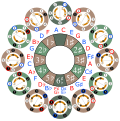Category:MTBR; scales fingering
| This image set is part of Music theory blue red. |





The images in this set show a left and right hand fingering for all musical scales.
The same fingering is used for relative keys.
These are 24 fingerings, namely left and right hand for each of the 12 positions in the circle of fifths.
These exact fingerings are meant for scales preceded and followed by the same one.
The first finger of the first and the last finger of the last scale sometimes need to be adapted.
E.g. for the A minor scale the A for the right hand is notated as the thumb. Obviously at the end the little finger is to be used instead.
Similarly for the C minor scale (3♭) the C for the left hand is notated as the thumb, but at the beginning the ring finger is to be used instead.
There are two pairs of white keys on the keyboard: B/C (3/4) and E/F (8/9)
An important characteristic of a scale is which key from each pair is in it:
The ♭ scales (1♭-5♭) contain the tones C and F (4 and 9), i. e. the right tone from each pair.
The ♯ scales (1♯-5♯) contain the tones B and E (3 and 8), i.e. the left tone from each pair.
The scales with 0 and 6 accidentals in the middle are the only ones that contain both 3 and 9 (B/F for 0 accidentals, B/E♯ for 6♯, C♭/F for 6♭).
See also File:Circle of fifths, clock and tonnetz.svg.
Each fingering partitions the tones of the scale in a group of three and a group of four fingers (the latter including the ring finger).
This graphic shows basically two types of fingering:
la-do for scales with few accidentals: The group of three fingers goes from la (minor leading tone) to do (major leading tone).
pair for scales with many accidentals: The thumb is used for the keys in a pair of white keys (so that the thumb is never used for a black key).
The following table the fingering type by number of accidentals. (Only for 3♯ and 2♭ left and right hand use a different type.)
The small additions in parentheses are meant in the following way:
The scales with 4♯ have the type pair. For the left hand this is the same as la-do.
The scales with 1♯ have the type la-do. For the right hand this is the same as pair.
| 6♯ | pair | |
| 5♯ | pair | |
| 4♯ | (la-do) pair | |
| 3♯ | la-do | special |
| 2♯ | la-do (pair) | |
| 1♯ | la-do | |
| la-do | ||
| 1♭ | (pair) la-do | |
| 2♭ | pair | la-do |
| 3♭ | pair (la-do) | |
| 4♭ | pair | |
| 5♭ | pair | |
This scheme suggests, that the right hand for 3♯ should be pair.
That would work, but starting the A major scale with the ring finger is rather unpractical, so a special form is used instead.
Subcategories
This category has only the following subcategory.
M
- MTBR; scales fingering; single (1 P, 13 F)
Media in category "MTBR; scales fingering"
The following 4 files are in this category, out of 4 total.
-
Circle of fifths, clock and fingers left.svg 4,131 × 4,138; 229 KB
-
Circle of fifths, clock and fingers right.svg 4,131 × 4,138; 223 KB
-
Musical scales fingering types.svg 227 × 440; 104 KB
-
Musical scales fingering.svg 679 × 2,768; 914 KB


